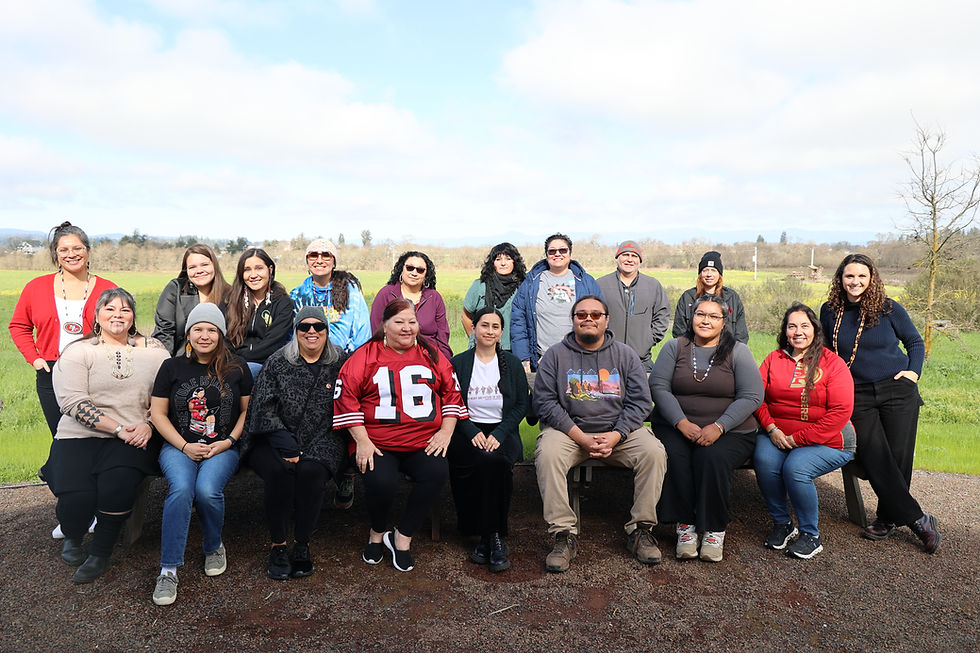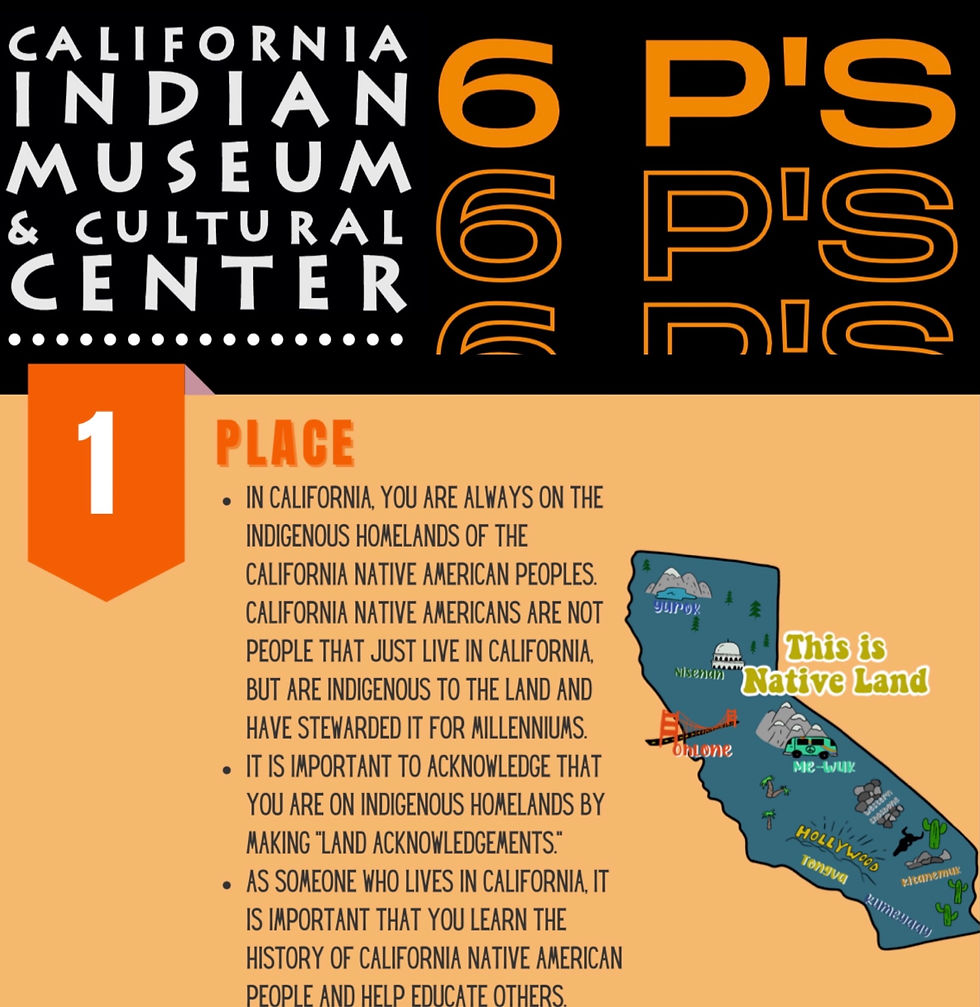Learning from Indigenous Perspectives All Year Long
- Redbud Resource Group

- Oct 15
- 5 min read
7 Do's, Don'ts, and Guidance for Teachers
By Trelasa Baratta, Education Specialist, Redbud Resource Group
As we reflect on Indigenous Peoples’ Day and prepare for Native American Heritage Month, we’re reminded of the power and relevance of Indigenous teachings in the classroom. We believe that integrating Indigenous perspectives into education isn’t a seasonal act. It’s a year-round commitment to honoring Native voices, respecting Tribal sovereignty, and deepening our relationships with land, history, and community. Not just for one day or month, but all year long.

Caption: Professional Development Training for Native Educators, led by Redbud Resource Group Staff, at the Laguna de Santa Rosa Foundation in Sebastopol, CA.
Indigenous teachings remind us that learning is not separate from life, and that education is rooted in relationships: to land, to community, to ancestors, and to ourselves. Incorporating Indigenous perspectives into your teaching practice helps all students see the world through a lens of respect, reciprocity, and responsibility.
As educators, your role in this journey is vital. The guidance we offer here is grounded in years of collaboration with Native partners and educators across California. These do’s, don’ts, and reflections are designed to help you move beyond performative inclusion and into practices rooted in respect, reciprocity, and relationship-building.
1. DO Learn From What’s Shared — DON’T Teach Someone Else’s Culture
Native cultures are living, dynamic, and rooted in place. It’s not your role to interpret or teach ceremonies, songs, or sacred practices. Instead, learn from what Native people have already chosen to share and guide students to explore their own relationships with the world.
Guidance: If Native people speak about their sacred relationship with the land, don’t try to replicate their ceremonies. Instead, invite students to cultivate their own connection through observation, reflection, or creating their own rhythms and songs. Amplify Native voices as they choose to share, and make it clear these perspectives belong to the people who hold them. Claiming them as your own is appropriation.

Caption: The 6 P’S: California Indian Curriculum from the California Indian Museum and Cultural Center: https://cimcc.org/the-6-ps-california-indian-curriculum/
2. DO Localize Your Lesson — DON’T Generalize
Indigenous peoples are not a monolith. Each Tribe has its own history, language, and ways of knowing.
Guidance: Always identify which Tribal community is connected to your lesson and ensure your materials reflect their specific perspectives. Avoid phrases like “the Native American way” and instead use “The [Tribal Name] people…” Context and specificity show respect and foster accuracy.

Caption: Cultural Demonstration Table, displayed by Rose Hammock (Pomo, Wailacki, and Maidu) sharing about common basket plants and techniques used by Pomo people.
3. DO Build Relationships with Guest Speakers — DON’T Treat Them as “One-Time” Resources
Inviting Native speakers into your classroom can be transformative, but it must be done respectfully.

Caption: Pomo Culture Bearer, Corine Pearce (Pomo), sharing plant knowledge with participants at the Cultural Fire Day hosted by the Tribal EcoRestoration Alliance in Hopland, CA.
Guidance: When bringing in or visiting Native guest speakers, come prepared:
Know who they are, learn about their work in advance, and ensure they are compensated for their time.
Respect the limited capacity of our communities. Many of us are balancing teaching, cultural responsibilities, and advocacy work, often with minimal support.
Plan ahead. Last-minute requests are rarely feasible and can feel extractive. Developing relationships takes time, so reach out well in advance with clear information about your goals, your students, and what kind of support you're requesting.
View these opportunities as the beginning of an ongoing relationship, not a transactional one. Consider how you can follow up, continue the connection, and share what your students learned. Relationships are at the heart of this work.
4. DO Use Indigenous Sources — DON’T Rely Solely on Non-Native Voices
Centering Indigenous voices ensures that students learn directly from Native perspectives.

Caption: A snapshot of the Native American Studies Model Curriculum: Grades 3-5 (check out the link below)
Guidance: Seek out materials created by Native educators, authors, and organizations. Redbud Resource Group offers a full library of Native-curated, replicable curriculum, and keep an eye out for the Native American Studies Model Curriculum project, which will release over 400 lessons by 2026. Use these resources, and many others, to ground your teaching in authentic voices, while showing students that Native peoples’ stories and knowledge are present, vibrant, and continuing today.
5. DO Highlight Strengths and Resilience — DON’T Only Focus on Struggle
History is hard, but how you frame it matters.

Caption: Participants in Redbud’s Feather River Advocacy Project learning about the impact of dams of salmon.
Guidance: Teach difficult histories through a lens of survival and resilience. Start with stories of cultural endurance, innovation, and leadership, then provide the context of systemic harms like colonization and displacement. This approach empowers students to see Native communities not as victims of history, but as thriving peoples who have persevered, and continue to lead today.
6. DO Keep Going — DON’T Let Fear Stop You
Fear of making mistakes can lead to silence, which erases Native peoples from classrooms altogether.
Guidance: This work can feel intimidating, but doing nothing causes more harm. Be open to feedback, willing to “unlearn,” and proactive in seeking guidance. If you’re ever unsure about a resource you’re using, or if you’re thinking about sharing a story or song you came across, reach out to me! Trelasa Baratta, Education Specialist, tbaratta@redbudresourcegroup.org.
We’re here to support you. We also offer private professional development workshops for schools ready to dig deeper into this work.
7. DO Embody Respect, Reciprocity, and Relationships — ALWAYS
At its core, integrating Indigenous perspectives is not just about adding content to a curriculum… It's about shifting how we teach and learn.

Caption: Native youth visiting Ya-Ka-Ama, a local non profit in Sonoma County, to learn more about the plants, animals, and original peoples (Southern Pomo) of this area.
Guidance: Approach every lesson with respect for the knowledge being shared, reciprocity in what you give back, and a commitment to building relationships with communities, with students, and with the land itself. These values are not just “Native principles,” they’re shared human values that make all learning richer.
Closing Thought
Teaching with Indigenous perspectives is not a checklist, it’s a mindset shift. When we root learning in respect, reciprocity, and relationship, we invite students into a broader story, one that uplifts the original peoples of this land and empowers all learners to be caretakers of truth, place, and community.
And you don’t have to do it alone! If you’re looking for support, we’re here to help. Let’s rebuild narratives and enhance school curriculum together.






Comments